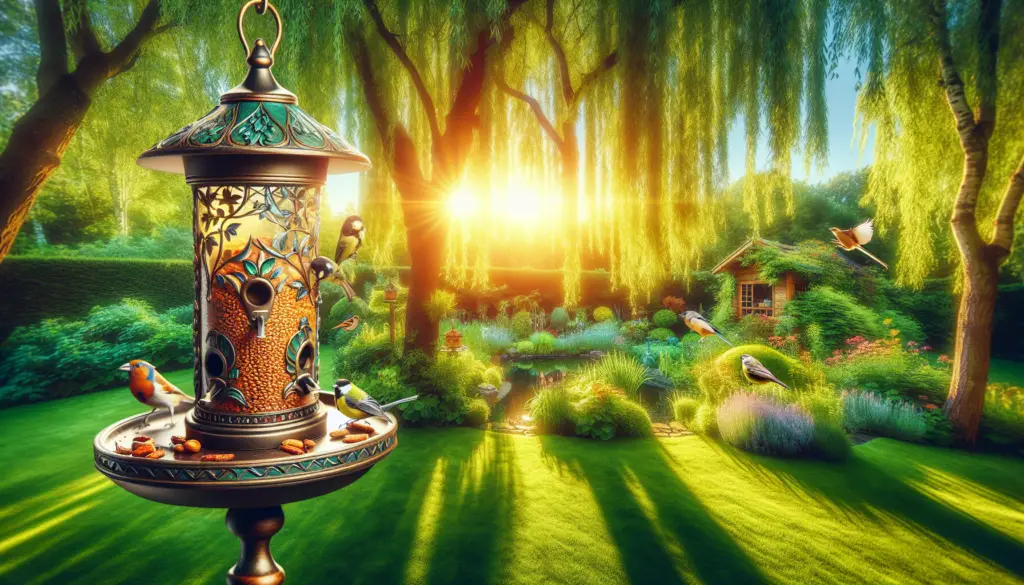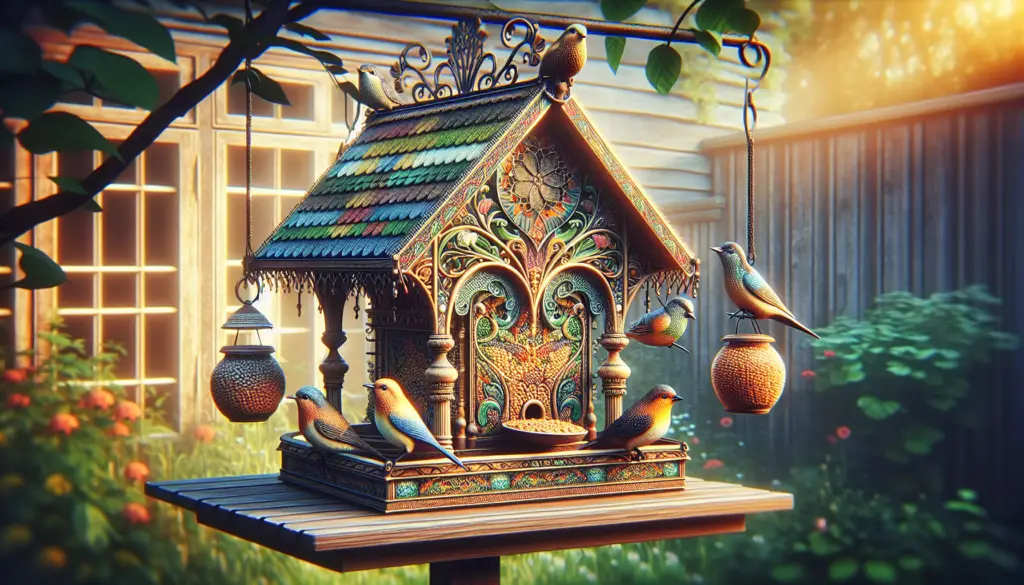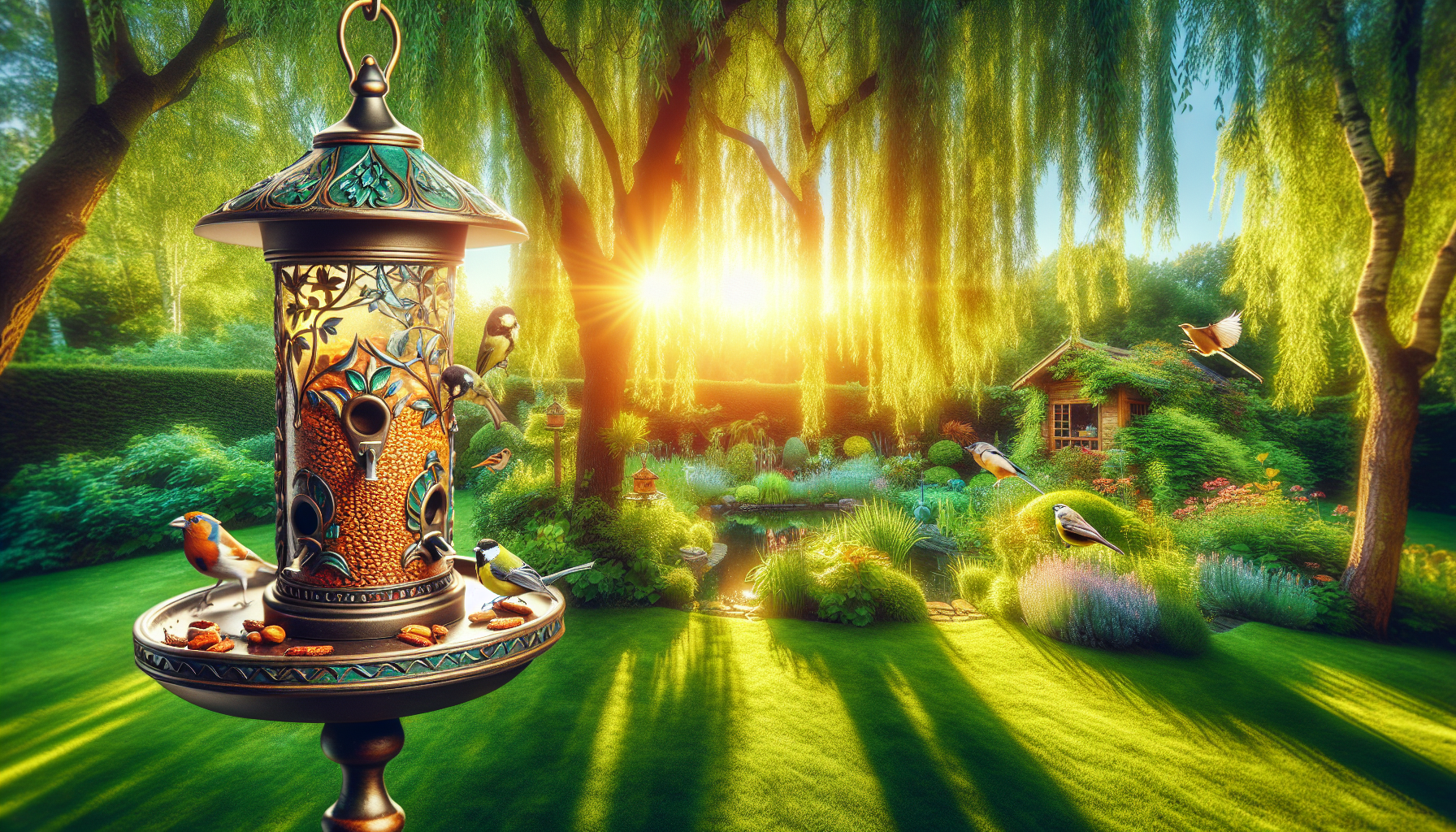So you’ve always admired the vibrant colors and beautiful songs of birds, and you’re yearning to create your very own avian oasis in your backyard. Luckily for you, we’ve got some incredible tips to help you invite these winged wonders to visit your outdoor space. From creating a welcoming environment with the right type of bird feeders and bird baths, to planting native plants that provide food and shelter, we’ve got all the insider knowledge you need to transform your backyard into a bird paradise. Get ready to be serenaded by the melodious trills and mesmerized by the graceful flights of your newfound feathered friends.
You can create a bird-friendly haven in your backyard by offering food, water, shelter, and nesting sites to attract feathered visitors. This will provide you with hours of entertainment watching colorful birds and support your local wildlife population.

Choosing the Right Bird Feeders
Determining the Ideal Bird Feeder Size
When choosing a bird feeder, it’s important to consider the size of the feeder. Different bird species have different feeding preferences and beak sizes, so selecting the right feeder size is crucial. Larger birds like cardinals and jays will require larger feeders with bigger perches and ports, while smaller birds like finches and chickadees will prefer smaller feeders.
Selecting Bird Feeders Based on Bird Species
Another factor to consider when choosing bird feeders is the specific bird species you want to attract. Different birds have different feeding behaviors and food preferences. For example, tube feeders with small ports are best for attracting small songbirds like finches, while tray feeders can attract a wide variety of bird species. Understanding the behavior and preferences of the birds in your area will help you select the right feeders to attract them.
Opting for Different Types of Bird Feeders
To attract a diverse range of bird species to your backyard, it’s a good idea to provide different types of bird feeders. Some popular types include tube feeders, hopper feeders, platform feeders, and suet feeders. Each type offers a unique feeding style and can attract different birds. By offering a variety of feeders, you can cater to the specific needs of various bird species and increase the chances of attracting a greater diversity of birds.
Providing Quality Bird Food
Understanding the Nutritional Needs of Birds
To attract birds to your backyard, it’s essential to provide them with high-quality bird food. Different bird species have different nutritional needs, so it’s important to understand what they require. Seeds, nuts, suet, and nectar are common foods that attract a wide range of birds. Research the specific dietary preferences of the birds you want to attract and choose bird food that meets their nutritional requirements.
Offering a Variety of Bird Food
To cater to the diverse dietary needs of birds, it’s best to offer a variety of bird food. Mixing different types of seeds, such as sunflower seeds, nyjer seeds, and millet, can attract various bird species with different feeding preferences. Additionally, providing suet blocks or balls can attract insect-eating birds like woodpeckers and nuthatches. Nectar feeders are a great way to attract hummingbirds and orioles, while offering fruits like apples and oranges can also attract certain bird species.
Avoiding Common Bird Food Pitfalls
While it’s important to provide bird food, it’s equally crucial to avoid common pitfalls. Make sure the bird food you provide is fresh, as stale or moldy food can be harmful to birds. Keep the feeders clean and free from debris to prevent the spread of diseases. Additionally, avoid using food that is heavily seasoned, salted, or contains preservatives, as these can be harmful to birds. Providing high-quality, fresh, and natural bird food will attract more birds and ensure their health and well-being.
Water Sources for Birds
Installing Birdbaths
Water is essential for birds, not only for drinking but also for bathing. Installing a birdbath in your backyard is an excellent way to attract birds. Choose a birdbath with a shallow basin that provides a secure footing for birds. Make sure to place it in a location that is easily accessible for birds but also offers cover and protection from predators. Keep the birdbath filled with fresh water and clean it regularly to prevent the growth of algae.
Creating a Water Feature
For a more elaborate water source, consider creating a water feature such as a small pond or waterfall. Water features can attract a wider range of bird species, as they provide a natural and appealing habitat for birds. Include different depths in the water feature to accommodate birds of varying sizes, and add rocks and plants to create perching and hiding spots. Ensure that the water is clean and flowing to prevent stagnation and attract more birds.
Taking Care of Water Sources
Maintaining the cleanliness of water sources is crucial for attracting birds. Regularly clean and refill birdbaths, removing any debris or algae that may have accumulated. If you have a water feature, ensure that the water is free from debris and regularly check and clean the pump or filters to keep the water flowing smoothly. By providing clean and fresh water sources, you will create a welcoming environment for birds and increase the chances of attracting a variety of species.
Landscaping for Birds
Planting Native Trees, Shrubs, and Flowers
Creating a bird-friendly backyard involves incorporating native plants into your landscaping. Native trees, shrubs, and flowers provide natural food sources and habitat for birds. Research the native plant species in your area that are known to attract birds and incorporate them into your garden. Oak trees, serviceberry shrubs, and coneflowers are just a few examples of plants that provide food and shelter for birds.

Creating Different Layers of Vegetation
To maximize the diversity of bird species in your backyard, it’s important to create different layers of vegetation. Include tall trees for perching and nesting, understory shrubs for shelter, and ground covers for foraging. This variety of vegetation layers will attract different bird species that utilize different parts of the landscape for various purposes. By creating a layered garden, you will provide a greater range of habitat options and increase the overall bird population in your backyard.
Including Berry-Producing Plants
Berry-producing plants are highly attractive to birds, as they provide a natural food source. Include plants like viburnum, holly, and elderberry in your landscaping to offer berries that birds can feed on. These plants not only provide food but also add beauty to your garden. Be sure to choose native berry-bearing plants that are suitable for your climate and soil conditions, as they will be more likely to attract local bird species.
Nesting Opportunities
Providing Nesting Boxes
Birds require suitable nesting locations to raise their young. Providing nesting boxes can attract cavity-nesting birds like bluebirds, chickadees, and titmice. Research the specific nesting requirements of the birds in your area and choose nesting boxes accordingly. Place the boxes in appropriate locations, offering protection from predators and adverse weather conditions. Regularly check the boxes to ensure they are clean and in good condition for the breeding season.
Maintaining Natural Nesting Areas
In addition to providing nesting boxes, it’s important to maintain natural nesting areas in your yard. Allow trees and shrubs to grow and provide suitable nesting sites for birds. Avoid excessive pruning or removal of dead trees, as they can provide important nesting opportunities for cavity-nesting birds and woodpeckers. By preserving natural nesting areas, you will create a welcoming environment for birds to nest and raise their young.
Avoiding Disturbance during Nesting Season
During the nesting season, it’s crucial to minimize disturbances around nesting areas. Avoid excessive noise, activities, or the use of tools near nesting sites, as this can disrupt and scare away nesting birds. Keep pets away from nesting areas and discourage unwanted predators like squirrels or raccoons from accessing the nests. By minimizing disturbances, you will create a safe and peaceful environment for birds to successfully raise their offspring.
Attracting Birds with Shelter
Using Birdhouses and Roosting Boxes
Birdhouses and roosting boxes offer additional shelter opportunities for birds. Place birdhouses strategically in your backyard, ensuring they are suitable for the bird species you want to attract. Different birds have different preferences when it comes to the size, entrance hole, and location of their shelter, so research the specific requirements of the birds you want to attract. Roosting boxes are also beneficial, providing shelter during harsh weather conditions and colder months when birds need protection.
Adding Brush Piles and Hedges
Creating brush piles and hedges can provide natural shelter for birds. Piles of fallen branches or brush can create hiding spots and protection from predators. Planting dense hedges or shrubs can also offer safe nesting locations and protection from the elements. These natural forms of shelter mimic the birds’ natural habitats and provide important refuge for them in your backyard.
Creating Bird-friendly Structures
Consider adding bird-friendly structures to your backyard to attract more birds. Adding a trellis covered with climbing plants can create a safe haven for birds to hide and build their nests. Installing a wooden pergola or arbor can offer perching spots and protection from the elements. Bird-friendly structures not only provide shelter and safety but also enhance the aesthetic appeal of your backyard.
Importance of Cleanliness
Regular Cleaning of Bird Feeders
To maintain a healthy environment for birds, it’s essential to clean bird feeders regularly. Dirty feeders can harbor bacteria and mold, which can be harmful to birds. Wash feeders with warm soapy water, scrubbing all parts thoroughly. Rinse them well and allow them to air dry before refilling them with fresh bird food. Regular cleaning will prevent the spread of diseases and ensure that birds have access to safe and hygienic food sources.
Keeping Birdbaths Fresh and Clean
Just like bird feeders, birdbaths also require regular cleaning. Stagnant or dirty water can become a breeding ground for bacteria and parasites, posing a threat to birds’ health. Empty and clean birdbaths at least once a week, using a brush or scrubber to remove any algae or debris. Rinse them well and refill with fresh water. Place birdbaths in locations that are easily accessible for cleaning to ensure that they remain clean and inviting to birds.
Maintaining a Clean Outdoor Space
In addition to cleaning feeders and birdbaths, it’s important to maintain a clean outdoor space overall. Remove fallen seeds, shells, and bird droppings from the ground and surrounding areas. This will not only keep your backyard tidy but also prevent the buildup of pests and diseases. Regularly rake or sweep the area around the feeders and birdbaths to maintain a clean and inviting environment for birds.
Offering Bird-Friendly Plants
Including Plants with Fruits and Seeds
To attract birds, it’s important to include plants in your landscaping that provide fruits and seeds. These natural food sources are highly attractive to birds and can supplement the bird food you offer in feeders. Plants like sunflowers, coneflowers, and dogwood trees produce seeds that many bird species enjoy. Berry-bearing plants like serviceberry and elderberry provide tasty treats for birds as well. By including a variety of plants that produce fruits and seeds, you can create a continuous food source for birds throughout the year.
Planting Flowers that Attract Birds
Flowers not only add beauty to your garden but also attract pollinators and birds. Choose flowers that have bright colors and produce nectar, as they are particularly attractive to birds. Hummingbirds are especially fond of flowers with tubular shapes, while other birds like finches and orioles enjoy flowers with smaller seeds or berries. Consider planting flowers like bee balm, salvia, and coneflowers to create a vibrant and bird-friendly garden.
Using Evergreen Trees for Year-round Shelter
Evergreen trees provide year-round shelter and protection for birds. These trees retain their foliage throughout the year, offering a reliable hiding place during harsh weather conditions and colder months. Planting evergreen trees like spruces, pines, and firs in your backyard can provide a permanent habitat for birds to nest and shelter in. The dense branches also offer additional perching spots, enhancing the overall bird-friendly environment in your backyard.
Minimizing Threats to Birds
Preventing Window Collisions
Window collisions are a threat to birds, causing injuries or even death. To prevent these collisions, there are several measures you can take. Applying decals or window film on large glass surfaces can make windows more visible to birds. Hanging window curtains or blinds can also help break up reflections and minimize the risk of collisions. Additionally, placing feeders and birdbaths farther away from windows can redirect bird activity and reduce the likelihood of collisions.
Reducing Pesticide and Herbicide Use
Pesticides and herbicides can be harmful to birds and other wildlife. Reduce or eliminate the use of these chemicals in your yard to create a safe environment for birds. Instead, opt for natural pest control methods such as planting companion plants, attracting beneficial insects, or using organic pest control products. By minimizing the use of harmful chemicals, you will protect birds from unintended harm and support a healthy ecosystem.
Protecting Birds from Predators
Birds are vulnerable to predation, and it’s important to take steps to protect them from potential predators. Avoid placing feeders or nesting boxes in locations that offer easy access for predators like cats or raccoons. Trim tree limbs near feeders to reduce the likelihood of squirrel access. You can also employ predator deterrents such as motion-activated sprinklers or ultrasonic devices to discourage predators from approaching bird-friendly areas. By minimizing predator threats, you will create a safer environment for birds to thrive in.
Conservation and Bird-friendly Practices
Supporting Bird Conservation Organizations
To take your bird-friendly practices to the next level, consider supporting bird conservation organizations. These organizations work towards protecting and preserving bird species and their habitats. You can make donations, volunteer, or participate in events organized by these organizations. By supporting their efforts, you contribute to the conservation of birds and help maintain their populations for future generations.
Participating in Citizen Science Projects
Engaging in citizen science projects can also contribute to bird conservation. These projects involve collecting data on bird populations, migration patterns, and breeding behaviors. By becoming a citizen scientist, you can contribute valuable information that helps researchers and conservationists better understand bird populations and make informed conservation decisions. Look for local or national citizen science projects and get involved in data collection and monitoring.
Spreading Awareness about Bird Protection
Lastly, spreading awareness about bird protection is crucial for conservation efforts. Educate your friends, family, and community about the importance of creating bird-friendly environments. Share your knowledge and experiences with others, encouraging them to adopt bird-friendly practices in their own yards. By raising awareness and inspiring others, you can help create a network of bird-friendly spaces that contribute to the overall well-being and conservation of birds.
In conclusion, attracting birds to your backyard requires a combination of providing suitable food, water, shelter, and nesting opportunities while minimizing threats and promoting conservation. By following these guidelines and implementing bird-friendly practices, you can create a welcoming environment for birds and enjoy the beauty and joy they bring to your outdoor space.

My name is Shane Warren, the author behind Your Bird Buddy – your ultimate guide to the wonderful world of birds! Unleash your inner avian explorer as we delve into a vibrant library of knowledge dedicated to all things feathered. From learning about diverse bird species from across the globe to understanding their captivating habitats and behaviors, I’m here to fuel your passion for these magnificent creatures. Not only that, but I also provide valuable insights on being a responsible and informed pet bird owner. Join our vibrant community and let’s celebrate the feathered wonders of the world together – one chirp at a time. And be sure to join our Your Bird Buddy Community over on Facebook!


Comments are closed